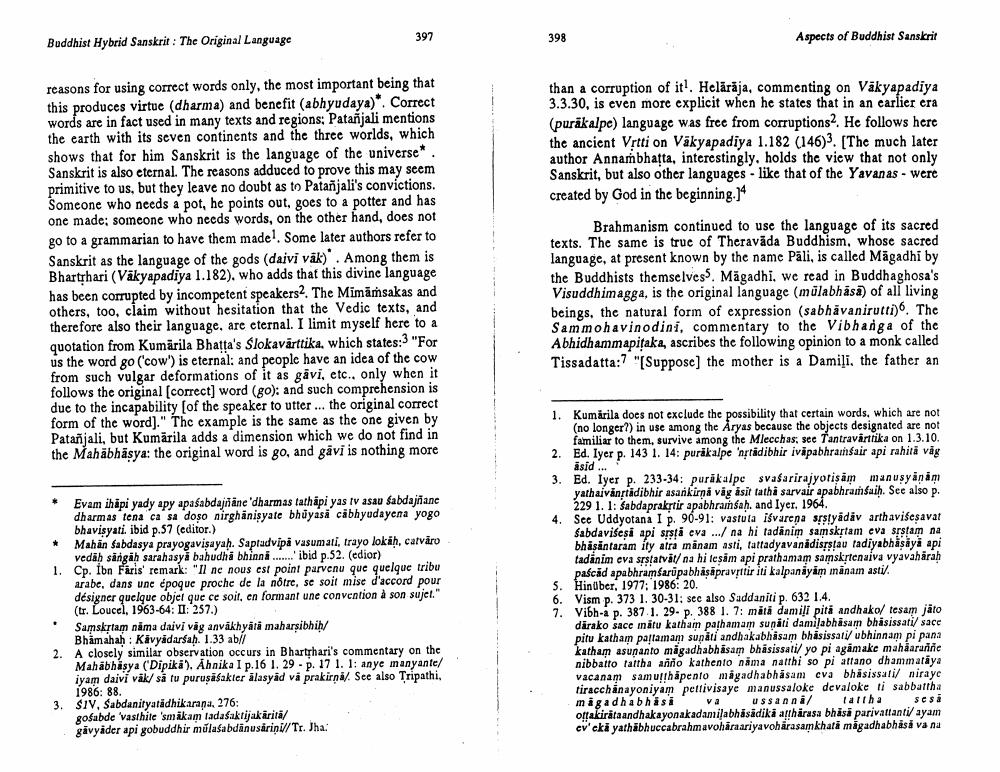Book Title: Buddhist Hybrid Sanskrit Original Language Author(s): Johannes Bronkhorst Publisher: Johannes Bronkhorst View full book textPage 2
________________ Buddhist Hybrid Sanskrit: The Original Language reasons for using correct words only, the most important being that this produces virtue (dharma) and benefit (abhyudaya)*. Correct words are in fact used in many texts and regions: Patanjali mentions the earth with its seven continents and the three worlds, which shows that for him Sanskrit is the language of the universe*. Sanskrit is also eternal. The reasons adduced to prove this may seem. primitive to us, but they leave no doubt as to Patanjali's convictions. Someone who needs a pot, he points out, goes to a potter and has one made; someone who needs words, on the other hand, does not go to a grammarian to have them madel. Some later authors refer to Sanskrit as the language of the gods (daivi vāk)". Among them is Bhartṛhari (Vakyapadiya 1.182), who adds that this divine language has been corrupted by incompetent speakers2. The Mimämsakas and others, too, claim without hesitation that the Vedic texts, and therefore also their language, are eternal. I limit myself here to a quotation from Kumarila Bhatta's Slokavärttika, which states: "For us the word go ('cow') is eternal: and people have an idea of the cow from such vulgar deformations of it as gävi, etc.. only when it follows the original [correct] word (go): and such comprehension is due to the incapability [of the speaker to utter... the original correct form of the word]." The example is the same as the one given by Patanjali, but Kumärila adds a dimension which we do not find in the Mahabhaṣya: the original word is go, and gavi is nothing more * Evam ihapi yady apy apasabdajñāne 'dharmas tathapi yas tv asau sabdajñane dharmas tena ca sa doso nirghänisyate bhūyasa cäbhyudayena yogo bhavisyati. ibid p.57 (editor.) Mahan sabdasya prayogaviṣayah. Saptadvipa vasumati, trayo lokaḥ, catvāro vedah sängäh sarahasya bahudha bhinna...... ibid p.52. (edior) 1. Cp. Ibn Faris' remark: "Il ne nous est point parvenu que quelque tribu arabe, dans une époque proche de la nôtre, se soit mise d'accord pour désigner quelque objet que ce soit, en formant une convention à son sujet." (tr. Loucel, 1963-64: II: 257.) * . Samskṛtam nama daivi väg anväkhyātā maharṣibhiḥ/ Bhamahah Kävyädarśaḥ. 1.33 ab/l 397 2. A closely similar observation occurs in Bhartṛhari's commentary on the Mahabhasya (Dipika). Ahnika I p.16 1. 29 - p. 17 1. 1: anye manyante/ iyam daivi väk/ så tu puruṣāśakter älasyad va prakirṇa/. See also Tripathi, 1986: 88. 3. SIV, Sabdanityatädhikaraṇa, 276: gofabde 'vasthite 'smäkam tadaŝaktijakäritä/ gävyäder api gobuddhir mulasabdanusarini//Tr. Jha: 398 Aspects of Buddhist Sanskrit than a corruption of it1. Helārāja, commenting on Väkyapadiya 3.3.30, is even more explicit when he states that in an earlier era (purakalpe) language was free from corruptions2. He follows here the ancient Vṛtti on Vakyapadiya 1.182 (146)3. [The much later author Annambhatta, interestingly, holds the view that not only Sanskrit, but also other languages like that of the Yavanas - were created by God in the beginning.]4 Brahmanism continued to use the language of its sacred texts. The same is true of Theravada Buddhism, whose sacred language, at present known by the name Pāli, is called Magadhi by the Buddhists themselves. Magadhi, we read in Buddhaghosa's Visuddhimagga, is the original language (mulabhasa) of all living beings, the natural form of expression (sabhavanirutti)6. The Sammohavinodini, commentary to the Vibhanga of the Abhidhammapitaka, ascribes the following opinion to a monk called Tissadatta: "[Suppose] the mother is a Damili. the father an 1. Kumarila does not exclude the possibility that certain words, which are not (no longer?) in use among the Aryas because the objects designated are not familiar to them, survive among the Mlecchas, see Tantravärttika on 1.3.10. Ed. Iyer p. 143 1. 14: puräkalpe 'nṛtādibhir iväpabhramsair api rahitä väg isid... 2. 3. Ed. Iyer p. 233-34: purakalpe svasarirajyotisam manusyäṇām yathaivänṛtädibhir asankirna väg äsit tatha sarvair apabhramsaiḥ. See also p. 229 1. 1: Sabdaprakṛtir apabhrainśaḥ, and Iyer. 1964. 4. See Uddyotana I p. 96-91: vastuta iśvarena srstyadav arthaviseṣavat Sabdavisesi api sṛstä eva.../ na hi tadanim samskṛtam eva srstam na bhäṣantaram ity atra mānam asti, tattadyavanädisṛstau tadiyabhäṣaya api tadanim eva sṛṣṭatvät/ na hi tesim api prathamam samskṛtenaiva vyavahāraḥ pascad apabhramsarupabhäṣapravṛttir iti kalpanayam mānam asti. Hinüber, 1977; 1986: 20. 5. 6. 7. Vism p. 373 1. 30-31; see also Saddaniti p. 632 1.4. Vibh-à p. 387.1. 29- p. 388 1. 7: mata damili pita andhako/ tesam jäto darako sace matu katham pathamam sunati damilabhasam bhasissati/ sace pitu katham paltamam sunati andhakabhasam bhasissati/ ubhinnam pi pana katham asunanto magadhabhasam bhasissati/ yo pi agamake mahaaraññe nibbatto tattha añño kathento nama natthi so pi attano dhammataya vacanam samutthäpento magadhabhasam eva bhasissati/ niraye tiracchanayoniyam pettivisaye manussaloke devaloke ti sabbattha magadhabhasi ussanna/ tattha ottakirätaandhakayonakadamilabhāsādika atthärasa bhāsä parivattanti/ ayam ev'eka yathābhuccabrahmavohāraariyavoharasamkhata magadhabhäsă va na va sesåPage Navigation
1 2 3 4 5 6 7 8 9 10 11 12 13 14 15
